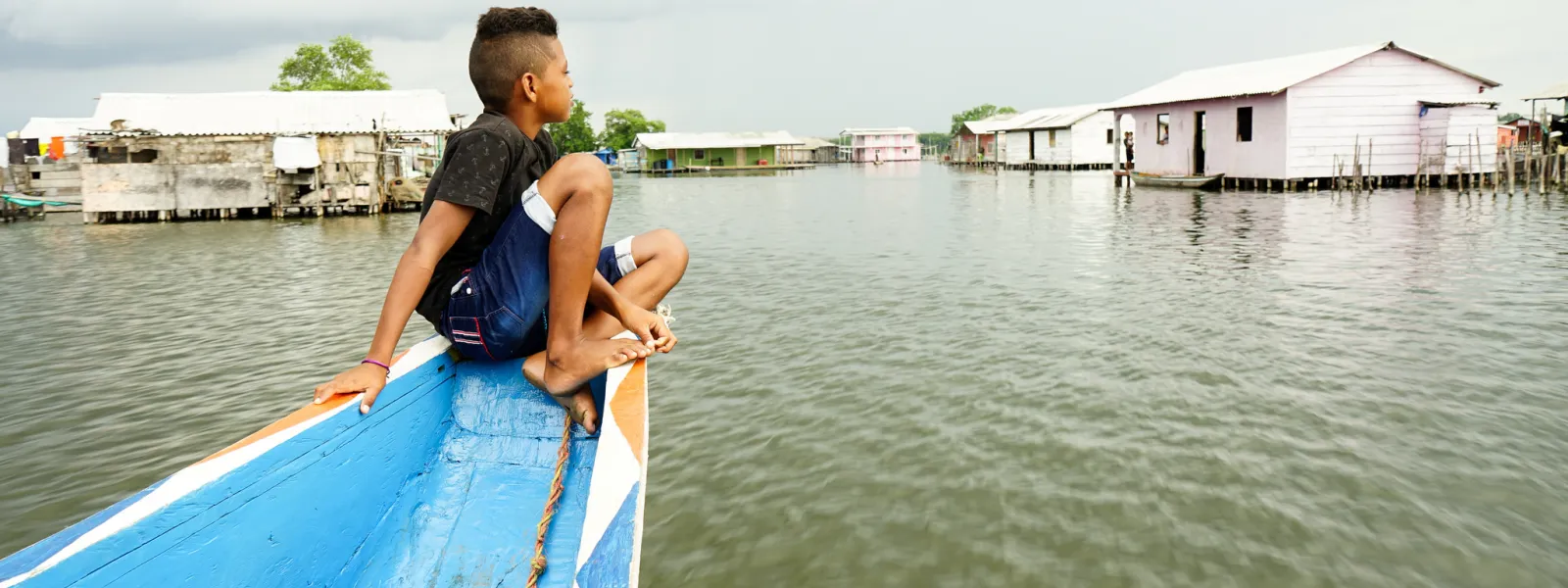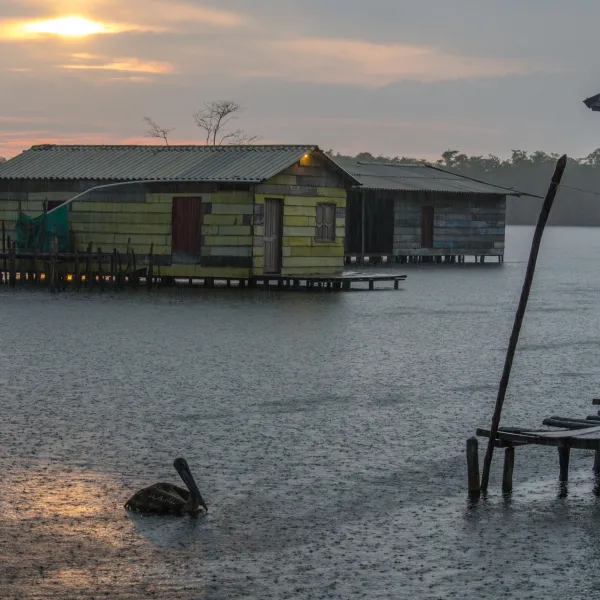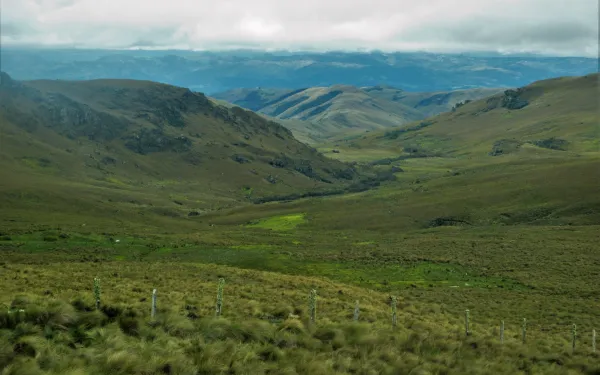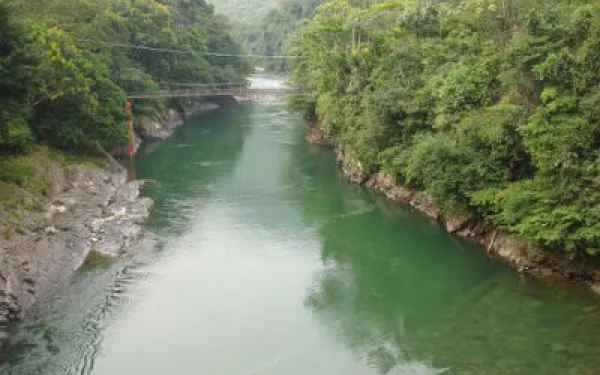
Project
Photo: Anna Laurie Miller / AIDAConserving the Ciénaga Grande de Santa Marta
Ciénaga Grande de Santa Marta, the largest and most productive coastal wetland in Colombia, covers 45,000 hectares. At the confluence of the Magdalena River and the Caribbean Sea, the site boasts an immense variety of flora and fauna, including mammals, birds and fish. Its southern tip is a beautiful sanctuary of mangroves, swamp and amphibious forest.
On the calm waters of the marsh stand the Ciénaga’s famous stilt villages, supported by pillars or simple wooden stakes and inhabited by local fishermen since 1800. In a place accessible only by water, many of the things we take for granted—being served a glass of water, quick access to a doctor—are considered luxuries. Residents depend on the natural world around them. Sadly, in recent years mass fish die-offs caused by the marsh’s degradation have threatened the livelihoods of 2,500 people who call the Ciénaga Grande home.
Illegal activities are destroying this vital ecosystem: intentionally set forest fires, deforestation of large tracks of land for agriculture and livestock, logging and burning of mangroves, and 27 kilometers of illegally built dikes.
This destruction not only devastates the local fishery; it also has global impact. Ciénaga Grande’s mangroves absorb large quantities of carbon dioxide from the atmosphere, aiding in the global fight against climate change.
The importance of the Ciénaga Grande has been recognized both nationally – the Sanctuary of Flora and Fauna Ciénaga Grande de Santa Marta is a national park – and internationally: UNESCO’s Man and the Biosphere program declared the lagoon a biosphere reserve; and the Ciénaga Grande is listed as a Wetland of International Importance under the Ramsar Convention, an intergovernmental treaty for the protection of wetlands.
AIDA and our partners are advocating for the Colombian government to fulfill its national and international obligations to protect the Ciénaga Grande. After all, millions of animals, the local community, and our global climate depend on it.
Partners:

Related projects

Letter presenting Latin American civil society organizations' concerns on the dilution of the World Bank's safeguards policies
Latin American civil society organizations "strongly recommend that CODE members send the first draft back to Management. Without structural changes to the Safeguard Policy proposal, we question if the second phase of consultations and the review process will be meaningful". According to them, dilution of the current Bank Safeguards Policy is evident throughout the draft. Basic World Bank requirements to assess and manage environmental risks and impacts before approval are now relaxed by providing the unbounded deferral of appraisal of significant environmental and social risks or impacts to implementation. A second major concern is that the draft proposed Social and Environmental Policy and ESSs significantly shift responsibility for safeguards implementation to borrowers, but provides less clarity than current exists on when/how the use of borrower systems would be preferable and acceptable. It remains unclear how the proposed draft will help the Bank and Borrowers make decisions to prepare or use borrower systems to effectively implement safeguards in countries where major dilutions of national social and environmental frameworks are being proposed or recently approved. "The proposed draft misses opportunities to meet the highest international standards. The draft provides no binding language regarding international human rights standards and allows governments to "opt out" of compliance to the Indigenous Peoples Policy to protect Indigenous Peoples rights, which unequivocally undermines the international consensus regarding the specific and fundamental rights of indigenous peoples over their lands, resources and the course of their own development", the organizations argue.
Read more
Giving People a Voice on Hydropower Projects
Hydropower projects are on the rise in Latin America as governments seek to feed growing economies. But at what cost? The plants may harness the energy capacity of running water, a renewable resource. But poorly planned and implemented dams, especially large ones, can bring myriad harms to the environment and communities. They affect fish and water quality, and they increase emissions of methane, a gas that contributes to global warming. Flooding displaces people from their homes and communities. This costs them their jobs as farmers, fishermen and hunters – and for ethnic and peasant communities, even their cultures and traditions. AIDA works with individuals and communities to protect them from poorly conceived and developed projects by using the law to defend their right to a healthy environment. This month AIDA and other organizations submitted a brief (in Portuguese) to Brazil’s Supreme Federal Court. The information demonstrates that congressional approval of the Belo Monte Dam in 2005 is illegal because the government didn’t guarantee the affected communities in the Amazon their right to consultation and free, prior and informed consent. Some meetings were held after approval of the project, and then with just scant and incomprehensible information in foreign languages for the communities. There was also little forewarning to attend. It was like telling you that your front yard is to become a street after the diggers have already started removing the lawn. The dam – which is to be the world’s third largest – is under construction and already displacing people without anyone giving them a chance to say no to the project in their own front yard. This is the first time that our combined efforts have reached the Supreme Court for a final decision on Belo Monte, said AIDA attorney María José Veramendi Villa. If the court rules against the legality of the project, then construction will have to stop and the harms righted for failing to consult the communities beforehand. If the opposite happens, the project will continue – and so will we. We will continue to provide assistance to the Brazilian Prosecutor’s Office as it pursues more than a dozen other cases against Belo Monte. These are cases that can also advance to the highest court with the goal of protecting communities from this and other dams in the Amazon. Our efforts to help communities fight dam projects are gaining attention. The Personería of San Carlos (the municipal ombudsperson), a town in northwestern Colombia, contacted AIDA to provide expertise in international environmental and human rights law. They want help in preventing the granting of a license for construction of the El Porvenir II Dam on the Samaná Norte, the last undammed river in the area. AIDA attorney and human rights and the environment fellow, Ana María Mondragón, went there to speak at a public environmental hearing for the project. The good news is that the dam has yet to be approved, meaning that there is still time for the communities to find out what could happen and voice their concerns. The government will have to take the community input into consideration before approving the project, with the possibility that the developer may have to amend construction plans – or abandon them altogether. El Porvenir II will affect fishing, a main source of work and food for the largely poor people in San Carlos. It will also flood an area where many Colombians are seeking to recover the lands that they were forcibly displaced from as result of an internal armed conflict that started more than five decades ago. “We have entered at an early stage, before the project has been approved,” said Mondragón. “We intervened in the hearing to show the inconsistencies in the environmental impact assessment made by the company and the harms that the Porvenir II dam would have in the community. We hope this will help the authorities in their decision-making process to not grant the license.” With your help, we can keep assisting Latin American communities free of charge to exercise their right to say what happens on their land and defend themselves with the law.
Read moreOrganizations submit amicus curiae brief to Brazil’s Supreme Federal Court, demonstrating that Congressional authorization of the Belo Monte Dam is illegal
The authorization violates national and international law because the communities affected by the project were not consulted. Construction of the dam continues, causing harms to people, communities and the ecosystem of the Brazilian Amazon. Brasilia, Brazil. Construction of the Belo Monte Dam continues. Meanwhile, biodiversity and the communities of the area already suffer severe damage. Civil society organizations submitted to the Supreme Federal Court an amicus curiae (in Portuguese) (friend of the court) brief that demonstrates that the Congressional decree authorizing the controversial dam is illegal because the government didn’t consult with the affected communities. The brief contains national and international law arguments for the protection of the environment and human rights. The arguments support a legal action filed by the Federal Prosecutor’s Office (Ministério Público Federal), which seeks a Supreme Federal Court ruling that annuls the decree. The Interamerican Association for Environmental Defense (AIDA) prepared the document in cooperation with the Centro de Estudios de Derecho, Justicia y Sociedad (DEJUSTICIA), Instituto Socioambiental (ISA), la Associação Indígena Yudjá Mïratu da Volta Grande do Xingu (AYMÏX) and the Conselho Indigenista Missionário (CIMI). "The Belo Monte project was approved without the State having consulted and obtained the consent of the affected indigenous communities and traditional populations. This, alongside the environmental degradation that began with construction, has placed the individuals and communities in a situation of extreme vulnerability," explained AIDA’s attorney, María José Veramendi Villa. By not guaranteeing the right to free, prior and informed consent of the affected communities before authorizing the project, Congress violated the Brazilian Constitution and Convention 169 of the International Labor Organization (ILO). Even though public information meetings about the project were held, they did not constitute prior consultation because they were held after the project was approved. Additionally, information provided in the meetings was not translated into indigenous languages. Not all the affected people had access to the meetings and those who did received incomplete and last minute information about the project. As well as the issues related to free, prior and informed consultation and consent, the document reinforces the Federal Prosecutor’s arguments with regard to the right to access to justice. This right was violated when the government used a law known as Suspension of Security to suspend lower court decisions against the project and favorable to the affected population, ostensibly to protect public security and the economy. "If the Supreme Federal Court issues a favorable decision, the Brazilian State will have two obligations. Not only will it have to suspend the authorization it gave for the dam’s construction, but also it will have to remedy the past and ongoing harm inflicted on indigenous communities and other populations affected by Belo Monte," said Dejusticia’s international director, César Rodríguez Garavito. "Traditional populations affected by the dam are living in unacceptable conditions for democratic times. There is a judicial decision that recognizes that the right to prior consultation was violated, but at the same time another, preliminary and provisional, decision that authorizes construction to move forward," said Leonardo Amorim, an attorney with Instituto Socioambiental. "Consequently, this population suffers worsening health conditions and invasion of their lands. We hope that the Supreme Federal Court rejects this situation." This past Tuesday, the Xingu Alive Forever Movement (MXVPS), with the support of several organizations, requested a hearing (in Portuguese) with the President (Chief Justice) of the Supreme Federal Court to demand an immediate decision in this legal action, as well as in others that challenge large hydroelectric projects in the Amazon.
Read more